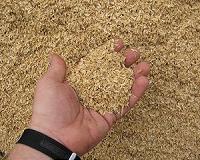 |
Madison WI (SPX) May 13, 2011 As concerns about air pollution from large dairies and other concentrated animal feeding operations (CAFOs) continue to mount, scientists are reporting a practice that could cut emissions of an exceptionally abundant agricultural gas-ammonia-by up to 30%. In the May-June 2011 issue of the Journal of Environmental Quality, a team led by Mark Powell, a soil scientist with the USDA Agricultural Research Service's U.S. Dairy Forage Research Center in Madison, WI, describes how natural plant compounds, known as tannins, can reduce both the amount of nitrogen cows excrete in urine, and the action of a microbial enzyme in manure that converts the nitrogen into ammonia on the barn floor. The U.S. EPA already monitors ammonia emissions from large animal operations under the "Superfund" act, and in April a coalition of citizen groups petitioned the agency to begin regulating ammonia under the Clean Air Act, as well. Besides its pungent smell, ammonia that volatilizes from cattle manure is highly reactive in the atmosphere, forming particulates that travel long distances and contribute to environmental problems such as acid rain, nutrient pollution, and smog. Feeding tannins to cattle could not only help dairy farmers reduce these impacts and meet regulatory standards, Powell says, but tannins could also boost nitrogen use efficiency in cows, thereby decreasing the need for expensive protein supplements. Only 20 to 35% of feed nitrogen ends up in milk on commercial dairy farms, with the remainder excreted about equally in manure and urine as the compound, urea. Urea is produced when nitrogen-rich proteins break down mainly in the cow rumen, forming ammonia gas that's eventually converted to urea before being excreted. Tannins are thought to cut urea production by somehow allowing more protein to escape digestion in the rumen and enter the cow intestine, where it's used more efficiently to produce milk protein. Tannins are perhaps best known for their role in leather tanning, but Powell began investigating them in ruminant feed more than two decades ago in West Africa. In the communities where he worked, tannin-rich shrubs were grown as windbreaks, and to amend the soil and feed livestock. Tannins in the diets of cattle, sheep and goats are in fact well-studied in the tropics, where vegetation tends to be naturally higher in the astringent plant chemicals, Powell explains. "But tannin research, in terms of ruminant nutrition, is relatively new in temperate environments." In the new study, Powell and dairy scientists from the University of Wisconsin-Madison fed tannin extracts from red quebracho and chestnut trees to dairy cows that also received two concentrations of crude protein: a low level of 15.5% protein, and a higher one of 16.8%. What they found is that dietary tannin cut ammonia emissions from the cows' manure by an average of 30% at the low protein level, 16% at the high level, or 23% overall. In other words, cows that consumed tannin expelled significantly less urea, thus making less available for conversion to ammonia. But a drop in urea production wasn't the only effect. To his surprise, Powell discovered that tannins also appear to inhibit urease, the enzyme that converts urea to ammonia. Urease activity in the feces of tannin-fed cows was significantly lower than in the feces of control animals, resulting in an 11% drop in emitted ammonia-or one-third of tannin's total impact on emissions at the high protein level. And when the researchers applied tannin directly to manure on the barn floor (rather than feeding it to cows), the effect was even greater: Ammonia emissions declined by nearly 20%. The tannin sources investigated in the study are already approved for animal feed, and "the levels we used amount to pennies per cow per day," Powell says, suggesting they could offer a cost-effective means to cut ammonia losses from the barn floor, as well as from manure that's applied to farm fields as fertilizer. Powell is now working with chemists to determine exactly which compounds in the tannin mixtures produce the effect, with an eye toward manufacturing a synthetic substitute later on. In the meantime, he has his sights on another important air pollutant that is prodigiously produced by cows. "We have another experiment looking at higher doses of tannin in dairy cattle," he says. "We want to see if it can reduce methane emissions." The full article is available for no charge for 30 days following the date of this summary.
Share This Article With Planet Earth
Related Links American Society of Agronomy Farming Today - Suppliers and Technology
 'Liquid smoke' from rice shows potential health benefits
'Liquid smoke' from rice shows potential health benefitsWashington DC (SPX) May 13, 2011 Liquid smoke flavoring made from hickory and other wood - a mainstay flavoring and anti-bacterial agent for the prepared food industry and home kitchens - may get a competitor that seems to be packed with antioxidant, antiallergenic and anti-inflammatory substances, according to a new study in ACS' Journal of Agricultural and Food Chemistry. It is the first analysis of liquid smoke produced from ... read more |
|
| The content herein, unless otherwise known to be public domain, are Copyright 1995-2010 - SpaceDaily. AFP and UPI Wire Stories are copyright Agence France-Presse and United Press International. ESA Portal Reports are copyright European Space Agency. All NASA sourced material is public domain. Additional copyrights may apply in whole or part to other bona fide parties. Advertising does not imply endorsement,agreement or approval of any opinions, statements or information provided by SpaceDaily on any Web page published or hosted by SpaceDaily. Privacy Statement |